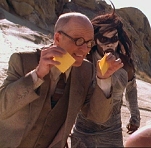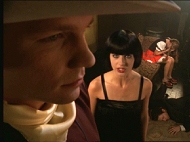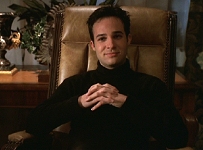|
||||
|
|
+THAT POSTMODERN THING+
Season 6 references up to 6.17 'Normal Again' - you have been warned! The first thing
anyone notices about Buffy is, well, it's called Buffy the Vampire Slayer.
A first and obvious criticism of the show is that it's 'not serious', that
Buffy is fluffy and generally silly. In a way, it is, because Buffy is
a show which is intrinsically postmodern, in which the idea of 'taking
yourself seriously' is not always relevant. Another first impression is
that the show is not 'original', that it's cliched, and recycles any old
horror or sci-fi. Again, in a sense it's not 'original' but this
is because it's postmodern.
FLUFFY
BUFFY
The First: You think you can fight me? I'm not a demon, little girl. I am something that you can't even conceive. The First Evil. Beyond sin, beyond death. I am the thing the darkness fears. You'll never see me, but I am everywhere. Every being, every thought, every drop of hate. Buffy:
Alright, I get it. You're evil. Do we have to chat about it all day?
But the horror genre usually takes itself pretty seriously, because it relies on the audience getting involved with the characters in order to be scared. But in this quote, there's a perfect example of the show not trying to be scary or deep; Buffy rejects all mystical seriousness of the First Evil in favour of a quip that releases the tension rather than building it. Other episodes, such as 'Band Candy', 'Teachers' Pet' and 'Go Fish', for example, seem to be deliberately stylistic and not very substantial; they are designed to be light and mostly funny. But while Buffy does frequently rely on simplicity, and style over substance, this isn't the way the whole show is constructed. Lightness is important, but the surface is never all there is. 'Band Candy' seems like a jokey episode, but in fact it has depth, and gives new insight into the characters. But is this not postmodern? Well, not really.While postmodernism does insist on the value of style over substance, it doesn't reject substance. Rather, it might be better to say that postmodernism rejects the idea that meaning must be injected into art, that there isn't meaning unless the art is complex and outwardly forbidding and confusing. Modernism sets more value by art and literature that tries to be art or literature, whereas postmodernism insists that there's as much, if not more, meaning to be found in something which doesn't compromise style in favour of substance. For postmodernists, something doesn't have to be unstylish or unconcerned with surface to have substance. 'Restless' seems to be an example of the show wholly going against the idea of simplicity and surfaceyness. The episodes tries to be oblique, opaque even, and tries to have a great deal of hidden meaning. But is 'Restless' not postmodern, then? Is it in fact modernism? Not at all. 'Restless' seeks to be complex, but it's also very stylistic; not everything in 'Restless' has a specific intended meaning, and much of it is done for its own sake. In the DVD commentary, Joss Whedon talks about the films which influenced him, and the effects he was trying to achieve; while the hidden meanings in the episode are important, the style of the episode is central. Postmodern texts are almost never purely stylistic, purely about the surface, and 'Restless' is no exception. Unlike modernists, postmodernists don't insist that the viewer, listener or reader deciphers their work. So you can decipher 'Restless', and it's doubtlessly intended that you could, but it also works as an entertaining and funny piece of television. 'Hush' worked on many levels, but chiefly it worked on the superficial TV-episode-without-talking level; complexity is there, but 'Hush' doesn't need to be 'deciphered' to work. PASTICHE
PASTICHES
Buffy exists are a part of the horror genre, but it also seeks to pastiche it. Unlike satire, which represents something satirically in order to make a specific point about it, pastiche pastiches something purely for the sake of it; because they can. In its time, Buffy has done the creature from the black lagoon, werewolves, Frankenstein, the mummy, the bionic man, Dracula and of course the classic head-teacher-that-turns-into-a-giant-snake. Perhaps the last one may be original. Each time a new, Buffy twist is put on the story, but generally speaking the intent is to pastiche, rather than to satirise. Buffy is never soley a satire on the horror genre; while it does somtimes seek to make observations about horror (or science fiction or fantasy) through satire, generally speaking pastiche is the aim: as pastiche doesn't criticise what it's pastiching. Postmodernism
is always interested in stylistic plurality, in the mixing of popular styles
and genres, such as Joss' mixing of styles in 'Restless'. But on the more
regular basis, the show mixes genres. In an earlier DVD commentary, Joss
talks about the way that the show needed to use many different lighting
techniques and direction, sometimes within just one scene. This is a symptom
of the way the show is constructed; it isn't comedy, horror, romance, drama,
science fiction or fantasy, it's all of these, frequently at the same time.
Often, it's a genre-clash, horror suddenly undercut with drama, or romance
undercut with comedy. Postmodernists recognise that any work of art is
influenced by many genres, and that no one genre is more valid than another;
pulp horror and serious drama can go hand in hand. Equally, it's completely
impossible to ignore other genres and styles; it's not unoriginal to use
them, it's merely a natural produce of living in the postmodern age. Genres
are not artistically invalid, in the same way that no pop culture is invalid. BUFFY
ISN'T REAL
However,
there are instances in which Buffy has called into question the 'reality'
or plausibility of the Buffyverse. At times, there is a suggestion that
there is some kind of real world (the world the viewers live in), in which
vampires aren't real. In 'Tabula Rasa' and 'Halloween', some or all of
the Scoobies revert to this state. Quickly this new reality is exposed
as ignorance of the truth, but it seems to imply that the supernatural
elements of the show are fictional, taken from comics, myths and films,
rather than 'real'. The familar nature of the monsters in the Buffyverse
further suggests a certain fictionality, as if the characters were living
in a world where its very unreality is central. This fictionalised
world seems fragile. In the episodes 'Superstar' (Season 4) and 'Normal
Again' (Season 6) the whole elaborate world of the show was torn down;
in Season 5, Dawn was introduced, history was rewritten with apparent ease.
Many postmodernists, while acknowledging the importance and inescapability of history, have
made a feature of the fact that history itself is
a construct; Season 5 and 'Superstar' showed us that memories were constructs
and easily changed, and that the past can't be relied upon to ever be concrete
or objective.
These constructed worlds in Buffy are somehow less 'real', and more rooted
in genre or other cliches than is usual; Jonathan's world in 'Superstar'
drew on James Bond and on media perceptions of heroism, using a variety of
different formats (comics, TV, film, sport, advertising) to demonstrate Jonathan's
fake-heroeness. I'd also argue that Dawn's constructed personality, in Season
5, is taken from TV 'family drama' shows; she is the archetypical bratty
teenager (though later episodes seem to show her breaking out of this role). Whether or not this is an example of the show drawing attention to its
own fictionality, or 'Normal Again' presents the possibility that Buffy's world is itself a construct. For a while, the audience is expected to wonder how 'real' the show is; it's very significant that the new world Buffy finds herself in is more conventionally 'real' than that of the Buffyverse (vampires and demons are no longer real), similar to the group amnesia in 'Tabula Rasa' and 'Halloween'. This makes the audience wonder if Buffy is 'real'. Of course, it isn't, it's a TV show, but 'Normal Again' makes us question the believability of vampires and demons, and question whether or not we should 'believe' the show, and find it plausible. The ending of the episode seems to tell us that, while Buffy is never real, it's interesting, and exciting; so while it is a fictional construct, 'reality' is itself often no more real. Postmodernism always understands that texts are fictional, but also recognises that whatever we call 'real' or 'realistic' is often a construct itself. COMPLETELY
UNSERIOUS
Is seriousness not postmodern, then? Postmodernists often believe that no TV series, or any art, can take itself too seriously. I'd argue that's the better phrase, then; Buffy take itself seriously, but not too seriously. We're expected to believe, as Buffy and the Scoobies do, in the fight of good against evil, and in loves and romances in the Buffyverse. But, when it succeeds most, the show is always able to see and lighter perspective; even at the most intense moments, there are always jokes. This isn't really a lack of seriousness, but rather recognising that no piece of art can ever take itself entirely seriously. Not so much playfullyness over seriousness, as a use of both. But no postmodern text is expected to be completely light and unserious; even case studies in postmodernism usually take themselves seriously to some degree, and see themselves as unique rather than purely as a produce of pop culture and postmodernity. Buffy still remains postmodern, because postmodernism is very broad-ranging. The term can't be defined in any narrow way, as it's in its very nature to be obscure, and defy categorisation. Buffy is a supremely postmodern text, because it sees itself as part of a postmodern world, rather than as an isolated piece of art.
|








 an example of it making a point about the nature of
reality, is debatable; but this view of history is very postmodern.
an example of it making a point about the nature of
reality, is debatable; but this view of history is very postmodern.